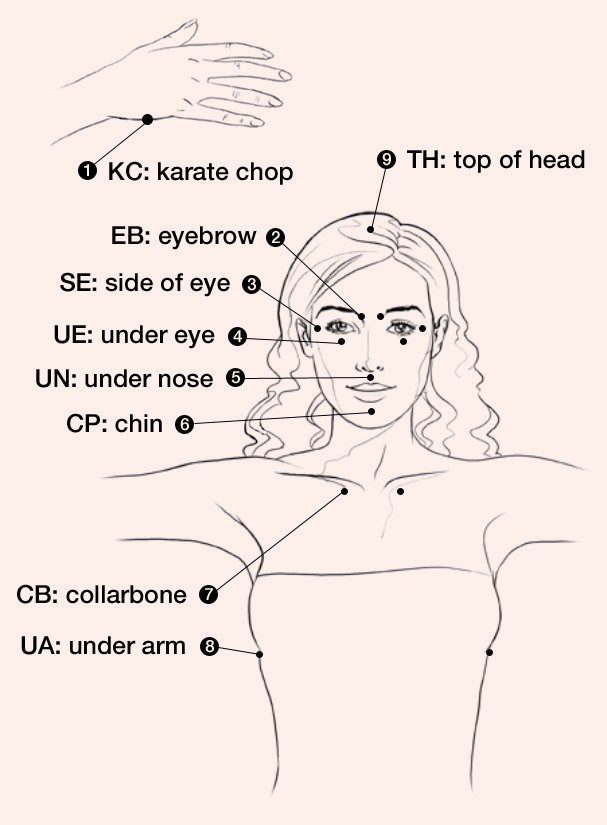When Kayla Bishop, a speech pathologist for Washingtonville Central School District, heard that someone was coming to her school to teach a stress-reduction technique to interested staff, she signed up for the course right away. At the time, she knew nothing about the modality called "tapping" (aka Emotional Freedom Technique or EFT). The course organizer had emailed a video about it, and Bishop was intrigued to see people tapping on acupressure points while talking through their emotional issues—and getting positive results. "It was amazing but hard to believe at first," she says. "I thought, does this really work? If I tap and talk to myself, will I reduce stress?" She was willing to let curiosity override her skepticism—especially if the technique had any chance of helping the stressed-out kids she worked with in middle and high school.
In the first class, instructor Catherine Masterson talked about how people use tapping to manage not just stress but an array of issues from overeating and chronic pain to anxiety and fear. Bishop perked up when she heard that tapping can also help people release various phobias, as she had long struggled with a phobia herself. "Ever since the second grade, I've had this fear where I faint every time I see blood," she says. "It got so bad that I wasn't getting physicals because I dreaded the bloodwork and had so much anxiety about the fainting." Masterson—a licensed RN and certified EFT practitioner with a master's degree in counseling—thought it would be interesting for Bishop to see what happened if she "tapped on" getting bloodwork before an upcoming (and three years overdue) doctor's appointment.
"Catherine worked one-on-one with me and told me what to say while I was tapping and what to look for with my feelings," Bishop recalls. Masterson also taught Bishop and her classmates how to find various acupressure points on the body, such as the side of the hand (the "karate chop" point), inside the eyebrows, below the nose, and on top of the head. In both acupuncture and acupressure, these points correspond with meridians, which are the pathways through which energy ("qi") flows through the body. While acupuncture uses some 300 meridian points, EFT typically uses just nine points on the body.
"For a whole week I tapped on [the acupressure points], saying things like, 'If I faint it's no big deal' and 'I want to be calm,'" Bishop says. "It was about letting myself choose to be calm instead of going in there all worked up like I usually do." To her amazement, the technique worked and she was able to go through with the bloodwork without incident. "It was the first time ever that I didn't faint while getting blood drawn," she says. "I was open-minded going into it, but I don't think I expected the tapping to be as successful as it was so quickly. My husband didn't believe me at first, but now he's buying into it more too. It worked instantly."
This Is Your Brain on EFT
Just what is this weird tapping thing, and how does it work? "We call it tapping because we are literally tapping on these endpoints of meridians on our body," says Nick Ortner, tapping expert and the author of four books on the subject, including The Tapping Solution: A Revolutionary System for Stress-Free Living (Hay House, 2013)."I like to describe it as a combination of ancient Chinese acupressure and modern psychology, because as we tap, we're saying certain phrases to focus on our problems, our issues, and our challenges," he says. "The latest research shows that when we tap on these endpoints of meridians in our body, we send a calming signal to the amygdala, the fight-or-flight response center (or stress center) of the brain. When someone is anxious, angry, overwhelmed, or stressed, that's the part of the brain that's firing. The tapping is a fast way to calm it down. People have this experience where they say, 'I don't know what just happened, but I was really angry and now I'm not.' Or, 'I was anxious and now I'm not anymore.'"
If it sounds woo-woo or pseudoscience-y, Ortner says there's a growing body of data piling up around tapping—and besides, it just seems to work for a lot of people. A self-described "seeker of ways to feel better," Ortner learned tapping from Gary Craig, who developed EFT in the 1990s based on a similar technique created by Dr. Roger Callahan called Thought Field Therapy (TFT). "I used it personally for a couple of years and was so inspired by it," says Ortner. "The running joke at the time was, 'Don't say anything is wrong around Nick, because he'll make you tap on it.'" In 2007, he made a documentary about tapping, and soon afterwards, with his siblings Jessica and Alex, he created The Tapping Solution organization. (Nick, Jessica, and Alex are kind of like The Trapp Family Singers of the tapping world.) The organization holds a free online summit yearly and, last year, released The Tapping Solution App, which offers over 100 guided tapping sequences with names like "Releasing Anxiety" and "Quiet My Racing Mind."
Tapping is taking off in certain circles of folks interested in self-help and alternative wellness, and naturally, there will be skeptics and nonbelievers, too. The technique is not endorsed by the American Psychological Association, and the studies behind it often come from researchers with a vested interest in the field—such as tapping expert Dawson Church, who has studied the technique's ability to reduce levels of the stress hormone cortisol. We need more studies to explore tapping's scientific efficacy, but without Big Pharma interest, there's less money in the coffers for expensive research. Yet unlike pharmaceutical drugs for anxiety and PTSD, tapping costs nothing, has no harmful side effects, and is basically risk-free (besides the risk of feeling a little silly the first time you do it). "Give it five to 10 minutes, and most likely, you're going to feel a difference," says Ortner. "If it doesn't work for you, then move on to something else."
A Way to Unwind If You Can't Sit Still
After Bishop's breakthrough experience of getting her blood drawn without fainting, she got excited about how tapping might help her in other ways too. "Anytime something stresses me out, I try to tap on it first because it helps me not react emotionally," she says, adding that she's able to think more clearly after using the technique. Bishop likes to be busy and on the move, so relaxation does not come easy to her. "Even when I'm at home, I think of the million things I can get done and I have my to-do list. It's not my nature to relax. I like yoga, but I have a hard time holding a pose. I have a hard time meditating and sitting still. What helps me with tapping is that you're moving, you're talking—and you feel better right away. For me, it's the best strategy."
So far, Bishop has used tapping only once with the kids in her class at Washingtonville Middle School, offering it to a group of sixth-graders before assigning them a listening-comprehension activity. "Typically, it's difficult for this group to focus and pay attention, so one morning I said, 'Let's try this.' We tapped while saying positive affirmations: 'I'm a great kid,' 'I'm going to try my best,' 'I'm amazing,' 'I respect myself.' Then we did the listening assignment, and they literally sat and did all the work in their seats quietly. I only tried it with them once, and I'm not sure it would go as well the next time, but it was amazing how focused they were." Another teacher who took Masterson's class tried tapping with a group of kids to reduce test anxiety, and some kids marveled that tapping helped them better remember what they'd learned.

The relationship between feeling calm and thinking more clearly has a basis in brain science, Masterson explains. "When you're stressed, you lose blood flow to the brain's frontal lobe, which is where clear thinking takes place," she says. "Tapping on the body has a calming effect, so it allows the blood to flow back to your frontal lobe." Adding to the sense of calm, tapping involves accepting your emotional state rather than fighting against it, which only creates more tension. "Of course, the technique doesn't take the source of stress away," adds Masterson, "but it helps you to be more effective, calm, and peaceful toward whatever is in front of you."
Tapping and Truth-Telling
Masterson's own journey with tapping started when she hit a wall using talk therapy with her adult clients. "I found it frustrating, because talk therapy sometimes gets you spinning," she says. "I wasn't seeing results. With EFT, people can have significant changes really quickly. They can get out of a story that keeps them stuck and get to the underlying issues that are subconscious."
These days, Masterson works with clients in person through her co-owned business—Luminous Heart Center, based in Poughkeepsie—or virtually via Skype. She says EFT is the number one tool in her toolbox. "Once you start tapping on the body, it's almost magical the way thoughts or memories will come forward. Those end up being the underlying themes that we work on [during a counseling session]. We can get to the nitty-gritty of what's holding the anxiety in place—the root source of the anxiety. It's an exploration. We're tapping the whole time, and that sends a signal to the brain that you're safe."
About four years ago, Masterson used tapping to help her elderly mother navigate a sudden crisis. "She was out walking when she fell and couldn't get up. Eventually, a person in the neighborhood helped her up and took her back home. When she came inside, she was badly bruised, bleeding, and literally shaking." Instinctively, Masterson started tapping on her mother to help calm her down. While her mother told the story of what happened, Masterson tapped on the acupressure points and repeated phrases that acknowledged and accepted her fears: "I was all alone, no one was there." In less than two minutes, she could see her mother's body let go of tension and relax so deeply that she almost fell asleep. After that, Masterson was able to bring her to the emergency room and get stitches. "The thing is, she wasn't afraid anymore. She was calm. She dealt with the emotional side right away, so it didn't become this traumatic experience for her.""I wasn't seeing results. With EFT, people can have significant changes really quickly. They can get out of a story that keeps them stuck and get to the underlying issues that are subconscious."
tweet this
While tapping has a growing community of fans, it hasn't attained widespread adoption in the same way that acupuncture, cognitive behavioral therapy, and meditation have—even though it draws on aspects of all three modalities. Perhaps one day, that acceptance will come. When it does, there's the exciting potential to use tapping to address the emotional side of being sick or injured, which is often just as important as the medical side. Meanwhile, either on YouTube or via The Tapping Solution App, you can find a tapping sequence for just about anything: insomnia, grief, loneliness, weight loss, migraines, pain relief, or even just a boost of happiness. "Everyone wants to feel better, calm the nervous system, and experience what peace feels like," says Ortner. "This is a tool to help you get there."













